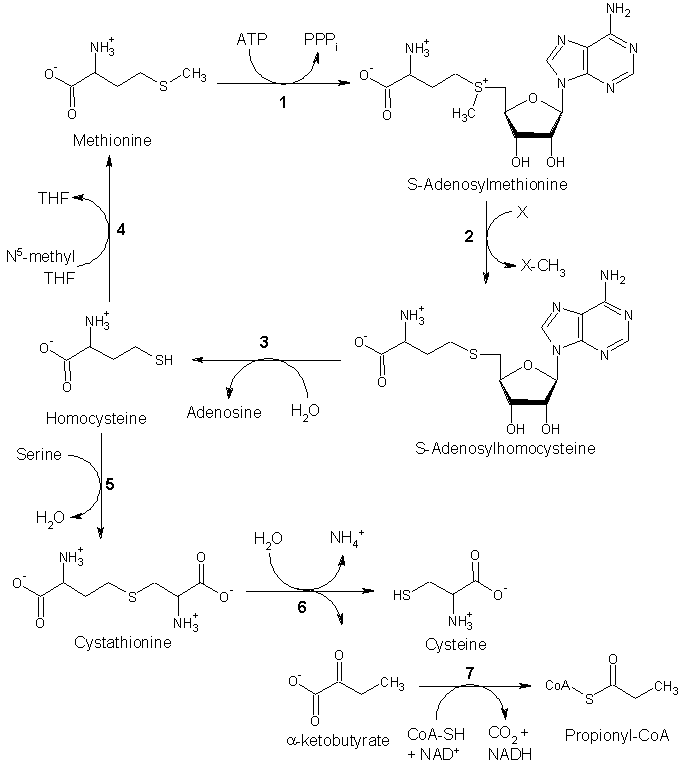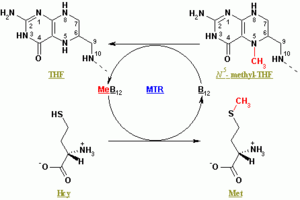
5-methyltetrahydrofolate-homocysteine methyltransferase
Encyclopedia
Methionine synthase also known as MS, MeSe, MetH is an enzyme
that in humans is encoded by the MTR gene
(5-methyltetrahydrofolate-homocysteine methyltransferase). This enzyme is responsible for the regeneration of methionine
from homocysteine
. Methionine synthase forms part of the S-adenosylmethionine (SAMe) biosynthesis
and regeneration
cycle.
 Methionine synthase catalyzes the final step in the regeneration of methionine
Methionine synthase catalyzes the final step in the regeneration of methionine
from homocysteine
.
Methionine synthase contains the cofactor methylcobalamin (MeB12) and uses the substrates N5-methyl-tetrahydrofolate
(N5-mTHF) and homocysteine
.
The enzyme works in two steps in a ping-pong reaction
. First, methylcobalamin is formed by a methyl group
transfer from N5-mTHF with formation of MeB12 and tetrahydrofolate (THF). In the second step, MeB12 transfers this methyl group to homocysteine, regenerating the cofactor cobalamin and releasing the product methionine
.

Methionine synthase is the only mammalian enzyme that metabolizes 5-mTHF to regenerate the active cofactor THF. Deficiency in methionine synthase function may be due to genetic mutations, reduced levels of its cobalamin cofactor (vitamin B12
), or decreased levels of the enzyme (methionine synthase) reductase
(required for the sustained activity of methionine synthase).
.
Enzyme
Enzymes are proteins that catalyze chemical reactions. In enzymatic reactions, the molecules at the beginning of the process, called substrates, are converted into different molecules, called products. Almost all chemical reactions in a biological cell need enzymes in order to occur at rates...
that in humans is encoded by the MTR gene
Gene
A gene is a molecular unit of heredity of a living organism. It is a name given to some stretches of DNA and RNA that code for a type of protein or for an RNA chain that has a function in the organism. Living beings depend on genes, as they specify all proteins and functional RNA chains...
(5-methyltetrahydrofolate-homocysteine methyltransferase). This enzyme is responsible for the regeneration of methionine
Methionine
Methionine is an α-amino acid with the chemical formula HO2CCHCH2CH2SCH3. This essential amino acid is classified as nonpolar. This amino-acid is coded by the codon AUG, also known as the initiation codon, since it indicates mRNA's coding region where translation into protein...
from homocysteine
Homocysteine
Homocysteine is a non-protein amino acid with the formula HSCH2CH2CHCO2H. It is a homologue of the amino acid cysteine, differing by an additional methylene group. It is biosynthesized from methionine by the removal of its terminal Cε methyl group...
. Methionine synthase forms part of the S-adenosylmethionine (SAMe) biosynthesis
Biosynthesis
Biosynthesis is an enzyme-catalyzed process in cells of living organisms by which substrates are converted to more complex products. The biosynthesis process often consists of several enzymatic steps in which the product of one step is used as substrate in the following step...
and regeneration
Regeneration (biology)
In biology, regeneration is the process of renewal, restoration, and growth that makes genomes, cells, organs, organisms, and ecosystems resilient to natural fluctuations or events that cause disturbance or damage. Every species is capable of regeneration, from bacteria to humans. At its most...
cycle.
Function

Methionine
Methionine is an α-amino acid with the chemical formula HO2CCHCH2CH2SCH3. This essential amino acid is classified as nonpolar. This amino-acid is coded by the codon AUG, also known as the initiation codon, since it indicates mRNA's coding region where translation into protein...
from homocysteine
Homocysteine
Homocysteine is a non-protein amino acid with the formula HSCH2CH2CHCO2H. It is a homologue of the amino acid cysteine, differing by an additional methylene group. It is biosynthesized from methionine by the removal of its terminal Cε methyl group...
.
Methionine synthase contains the cofactor methylcobalamin (MeB12) and uses the substrates N5-methyl-tetrahydrofolate
Levomefolic acid
Levomefolic acid or metafolin is the natural, active form of folic acid used at the cellular level for DNA reproduction, the cysteine cycle and the regulation of homocysteine among other functions. The un-methylated form, folic acid , is a synthetic form of folate found in nutritional supplements...
(N5-mTHF) and homocysteine
Homocysteine
Homocysteine is a non-protein amino acid with the formula HSCH2CH2CHCO2H. It is a homologue of the amino acid cysteine, differing by an additional methylene group. It is biosynthesized from methionine by the removal of its terminal Cε methyl group...
.
The enzyme works in two steps in a ping-pong reaction
Enzyme kinetics
Enzyme kinetics is the study of the chemical reactions that are catalysed by enzymes. In enzyme kinetics, the reaction rate is measured and the effects of varying the conditions of the reaction investigated...
. First, methylcobalamin is formed by a methyl group
Methyl group
Methyl group is a functional group derived from methane, containing one carbon atom bonded to three hydrogen atoms —CH3. The group is often abbreviated Me. Such hydrocarbon groups occur in many organic compounds. The methyl group can be found in three forms: anion, cation and radical. The anion...
transfer from N5-mTHF with formation of MeB12 and tetrahydrofolate (THF). In the second step, MeB12 transfers this methyl group to homocysteine, regenerating the cofactor cobalamin and releasing the product methionine
Methionine
Methionine is an α-amino acid with the chemical formula HO2CCHCH2CH2SCH3. This essential amino acid is classified as nonpolar. This amino-acid is coded by the codon AUG, also known as the initiation codon, since it indicates mRNA's coding region where translation into protein...
.

Methionine synthase is the only mammalian enzyme that metabolizes 5-mTHF to regenerate the active cofactor THF. Deficiency in methionine synthase function may be due to genetic mutations, reduced levels of its cobalamin cofactor (vitamin B12
Vitamin B12
Vitamin B12, vitamin B12 or vitamin B-12, also called cobalamin, is a water-soluble vitamin with a key role in the normal functioning of the brain and nervous system, and for the formation of blood. It is one of the eight B vitamins...
), or decreased levels of the enzyme (methionine synthase) reductase
(methionine synthase) reductase
In enzymology, a [methionine synthase] reductase is an enzyme that catalyzes the chemical reactionThe 3 substrates of this enzyme are methionine synthase-methylcobalamin, S-adenosylhomocysteine, and NADP+, whereas its 4 products are methionine synthase-cobalamin, NADPH, H+, and...
(required for the sustained activity of methionine synthase).
Clinical significance
Mutations in the MTR gene have been identified as the underlying cause of methylcobalamin deficiency complementation group G, or methylcobalamin deficiency cblG-type. The consequence of reduced methionine synthase activity is megaloblastic anemiaMegaloblastic anemia
Megaloblastic anemia is an anemia that results from inhibition of DNA synthesis in red blood cell production. When DNA synthesis is impaired, the cell cycle cannot progress from the G2 growth stage to the mitosis stage...
.
Genetics
Several polymorphisms in the MTR gene have been identified.- 2756A→G (Asp919Gly)
See also
- MethyltransferaseMethyltransferaseA methyltransferase is a type of transferase enzyme that transfers a methyl group from a donor to an acceptor.Methylation often occurs on nucleic bases in DNA or amino acids in protein structures...
- Arakawa's syndrome IIArakawa's syndrome IIArakawa's syndrome II is an autosomal dominant metabolic disorder that causes a deficiency of the enzyme tetrahydrofolate-methyltransferase; affected individuals cannot properly metabolize methylcobalamin, a type of Vitamin B12....
- 5-Methyltetrahydrofolate5-MethyltetrahydrofolateLevomefolic acid or metafolin is the natural, active form of folic acid used at the cellular level for DNA reproduction, the cysteine cycle and the regulation of homocysteine among other functions. The un-methylated form, folic acid , is a synthetic form of folate found in nutritional supplements...
(5-Me-THF, 5-Me-H4F)

